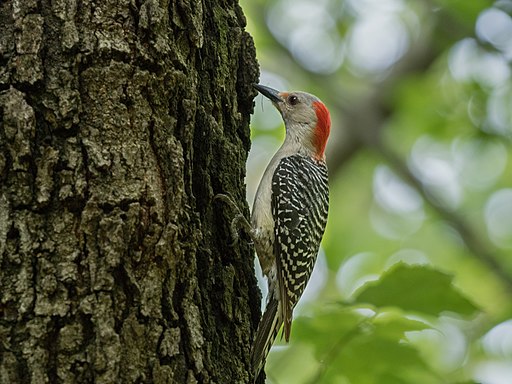Woodpeckers in Florida: Identification Tips and Environment Preferences
Woodpeckers in Florida: Identification Tips and Environment Preferences
Blog Article
Woodpeckers Unleashed: Exploring the Marvels of These Experienced Tree Mountain Climbers
Woodpeckers, with their unique markings and rhythmic drumming echoing through wooded locations, hold an one-of-a-kind location in the bird globe. Their specialized anatomy and adjustments allow them to navigate vertical surfaces with unparalleled skill. Nevertheless, their mastery of tree climbing is just one aspect of their interesting habits. As we look into the detailed information of woodpeckers' nesting practices, feeding techniques, and the ongoing conservation efforts to secure these impressive birds, a deeper gratitude for their location in nature unravels.
Anatomy and Adaptations
When analyzing the composition and adjustments of woodpeckers, one can observe remarkable attributes that make it possible for these birds to thrive in their specialized environmental specific niche. Woodpeckers are furnished with a suite of one-of-a-kind physiological features that aid them in their woodpecking actions. One of the most prominent attributes is their strong, chisel-like beak, which is specialized for drilling into timber to discover insects or develop nesting dental caries. This beak is supported by solid neck muscle mass and an extremely established head structure that works as a shock absorber, permitting woodpeckers to repetitively peck at trees without causing brain injury. Additionally, woodpeckers have zygodactyl feet, with 2 toes encountering onward and 2 dealing with backward, giving a company hold on tree trunks while they look for food or drum for communication.
Additionally, woodpeckers have an one-of-a-kind tongue framework that is long, barbed, and sticky, allowing them to extract pests from crevices in wood. This customized adjustment permits woodpeckers to make use of a food source that is inaccessible to lots of various other bird species. On the whole, the makeup and adaptations of woodpeckers showcase the exceptional transformative services that have permitted these birds to flourish in their arboreal habitat.
Drumming Habits
Having explored the anatomy and adaptations of woodpeckers, the emphasis currently changes to recognizing their drumming behavior, an unique aspect of their communication and territorial screens. Drumming is a crucial type of communication among woodpeckers, offering numerous objectives such as establishing regions, drawing in companions, and signaling alarm. Each woodpecker types has an one-of-a-kind drumming pattern that helps people acknowledge members of their very own types and distinguish them from competitors or killers.
Woodpeckers generate drumming noises by read the article rapidly pecking on resonant surfaces such as dead trees, utility poles, or even steel items, creating a series of rhythmic beats. The strength and speed of drumming can vary based upon the purpose; for example, a quick drumming series may signify aggression towards intruders, while a slower and softer drumming pattern might indicate courtship (Woodpeckers in Florida). Furthermore, woodpeckers might change the frequency and duration of their drumming to share particular messages effectively
Nesting Practices
Checking out the nesting routines of woodpeckers reveals remarkable understandings right into their reproductive actions and habitat options. Woodpeckers are recognized for their special nesting choices, commonly excavating dental caries in trees to develop sheltered rooms for increasing their young. These dental caries offer not just as a nesting website but also as a safe refuge from predators and inclement weather condition.
Woodpeckers show a high degree of fidelity to their nesting websites, typically going back to the exact same place time after time. This actions highlights the importance of suitable environment schedule for their reproductive success. The choice of a nesting site is crucial for woodpeckers, with aspects such as tree species, height, and degeneration stage playing significant functions in their decision-making process.
Surprisingly, some woodpecker varieties are understood to excavate multiple cavities within their area, offering themselves with different nesting options. This strategy might offer as a kind of insurance coverage against possible threats or disruptions to their main nesting website.

Feeding Techniques
One of the most unique feeding actions of woodpeckers is drumming, which involves rapid pecking on trees to reveal bugs under the bark. Woodpeckers are additionally known to dig deep into tooth cavities in trees to internet access surprise insect larvae or sap. Some varieties, like the acorn woodpecker, shop nuts in specially created openings called granaries.
Conservation Initiatives
In the middle of the intricate feeding techniques displayed by woodpeckers, the conservation initiatives aimed at safeguarding these interesting birds play a vital duty in protecting their habitats and populaces. Woodpeckers deal with various dangers to their survival, including habitat loss because of deforestation, climate change altering their environments, and collisions with man-made frameworks such as buildings and automobiles - Woodpeckers in Florida. Conservationists are actively working to attend to these challenges and make sure the lasting wellness of woodpecker types

Education and learning and public awareness campaigns are additionally crucial parts of woodpecker conservation initiatives. By increasing understanding regarding the significance of these birds in keeping healthy forest ecosystems, conservationists can gather support for environment conservation efforts and advertise accountable land administration practices. With collective initiatives in between researchers, policymakers, and regional communities, we can collaborate to safeguard a future where woodpeckers flourish in their natural environments.
Final Thought

Report this page